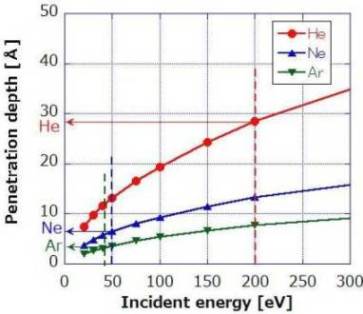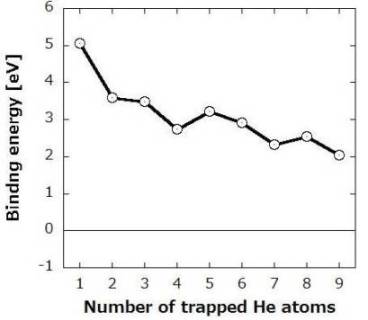ACTIVITY
6. Plasma-Wall Interaction Group
|
Tungsten material is one of promising candidates for divertor plates in
nuclear fusion reactors. Bubble formation is observed on the surface of
the tungsten material which is irradiated by helium plasma. Furthermore,
a number of experiments show that helium plasma constructs filament (fuzz)
structures whose diameter is in nanometer-scale on the tungsten material
under the suitable condition (i.e., material temperature of 1,000-2,000~K
and incident energy of 20-100~eV). The formation of these structures does
not only decrease the thermal conductivity of the material, but also enhances
the tolerance in cracking and the radiation efficiency. It also causes
reduction of sputtering yield. Some of theoretical models related to the
mechanism of fuzz formation were advocated. For example, the theoretical
using fluid model describing viscose effects in incompressible material
flow under impact of large stress was proposed. However, the formation
mechanism has not been well understood yet. Therefore, we, PWI group in
NSRP, are challenging to reveal the formation mechanism of the nano structure.
As the first step, we investigated the penetration depth for helium, neon,
and argon gases by binary-collision-approximation-based (BCA) simulation
to reveal the possibility of fuzz formation under noble gas irradiation.
The penetration depth strongly depends on the incident gases. Accoring
to our BCA simulation, only helium can invade the tungsten (Fig.1). Next,
we examine the binding energy of helium trapped in a tungsten monovacancy
using first-principles calculation based on density functional theory (DFT)
and investigate the trapping of multiple helium atoms within a tungsten
Monovacancy (Fig. 2). Calculation shows that a tungsten monovacancy can
contain at least nine helium atoms. We find that six monovacancy-trapped
helium atoms form a kind of a cluster structure with an octahedral configuration,
and the cluster structure is tightly bound around a monovacancy located
at the center of a W cube.
|
 |
|
Fig.1 Incident energy dependence of mean depth of He, Ne, and Ar injection
into tungsten material [S. Saito, et al., Journal of Nuclear Materials
438 (2013) S895].
|
 |
|
Fig. 2 Binding energy as a function of the number of He atoms trapped within
a W monovacancy [A Takayama, et al., Japanese Journal of Applied Physics
52 (2013) 01AL03].
|
Reference
|








 To NIFS
To NIFS